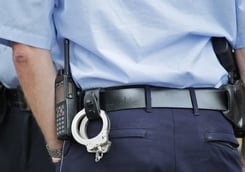Do you have to wear a duty belt in your line of work, but are wondering if you are wearing one correctly? Many security and police officers wear duty belts to hold their equipment. They allow officers to carry their equipment easily while leaving their hands free to interact with the world around them. But if the duty belt does not fit, or the pieces of equipment are not arranged correctly, it could cause many problems in the future, such as back pain and pelvic imbalances.
Factors to consider when setting up your duty belt for maximum ease and comfort
POSITIONING YOUR DUTY BELT
The most important considerations when setting up your duty belt are functionality and comfort. You need to be able to access your equipment easily without constantly adjusting due to discomfort or pain. Sometimes sitting in your patrol car for hours with an ill-fitting duty belt can take a toll on your back. Whether standing for long periods or wrestling with a subject, the duty belt needs to fit against your body snuggly without impeding your movements.
A good rule of thumb is that you should not wear more than 10 pounds of items at a time, as it could affect your back and posture in the long run. When positioning items on your duty belt, you need to evenly distribute the heavy items. For example, the side arm must be at the dominant side's hip. Other items of equal weight, such as flashlight, radio, and expandable baton holders, can be on the hip on the weak side. Along the back or front of the duty belt, you can position smaller items, such as a handcuff case and cell phone pouch. This will allow for the weight of your items to be evenly distributed to minimize pain and discomfort while making them easily accessible.
TESTING OUT YOUR DUTY BELT
After positioning the items on your duty belt, your work still isn’t done. You need to put it on to see how you can move while using your equipment. In addition, you need to know whether the gear remains secured to your body or if it flops around. You want the duty belt to allow you to move quickly and quietly while performing many of the essential day-by-day functions of your job.
Test out your duty belt by warming up around the compound or at the range. You want to ensure that the duty belt remains secure to your body and is comfortable. After warming up your body, you might want to complete a few dashes at full speed. While running, consider how your gear reacts. Do your items remain securely attached to your body, or do they flop around? You will be able to see if any of the items get dislodged so that you can adjust and fix them.
The last thing you will want to do is to test your stealth. As a police or security officer, stealth is an important characteristic as it can allow you to approach an unassuming suspect from behind. Try hopping up and down several times while listening for any sounds. The main culprit for loud sounds is usually the keys, which you can
easily fix by wrapping them with a rubber band.
WEARING YOUR DUTY BELT
There are many different types of duty belts. Some are fastened with velcro, while others have buckles. Choosing the right duty belt depends on your position and style. You need to choose one that is durable, strong, and rigid to withstand the often physical aspects of your job while maintaining comfort.
You can set up your duty belt by using the belt keeper system. Using this system, you would attach a duty belt to your inner belt with a series of keepers. These keepers are positioned strategically to give the snug fit of the belt. Once you unsnap the keepers, the entire duty belt comes off in one piece. This means you can easily and quickly remove your duty belt when getting out of uniform. While you may have to purchase the keepers separately, some duty belts are already equipped with them. For example, the Raine Pro Series Duty Belt has sturdy belt keepers that you can securely attach to your inner belt. You would still have to purchase an inner belt separately, such as the Raine Velcro Trouser Belt.
You can choose from other duty belts, depending on your particular need. For example, if your job requires you to regularly go through metal detectors, you might want to consider the Propper Tactical Duty Belt. As it comes with a plastic belt buckle that seamlessly slides in and out, you will be able to pass through metal detectors without removing it. Another duty belt that is worth considering is the Bianchi PatrolTek Duty Belt. This belt is loop lined and made from durable and tough construction. With a shatter-resistant 3-point buckle, you can have peace of mind knowing that it won’t release inadvertently. These duty belts are slim and for everyday use.
But if you need a duty belt that can withstand some of the more physical aspects of the job, then you can choose one that is more heavy-duty. Police officers might appreciate the Raine Police Grade Duty Belt, made of durable construction with a sturdy buckle that is sturdy enough without sacrificing comfort. Another option is the Condor Battle Belt which offers plenty of side panels and hooks to securely attach it to your inner belt. You can also connect the belt to your harness with the attached hooks. These duty belts are simple to set up while keeping you comfortable no matter where your job takes you.
Set Your Duty Belt Up for Comfort and Function
Learning how to set up a duty belt correctly is important for your health and overall well-being. You want the duty belt to fit you so that it is comfortable and functional. Plus, the quality of products you use can make a difference too.
Shop tactical duty belts online with Army Navy Gear's vast selection. These tactical duty belts and accessories can help ensure your equipment is secure and within easy reach without sacrificing comfort and functionality. Whatever your job, we’ve got the right duty belt for you!






